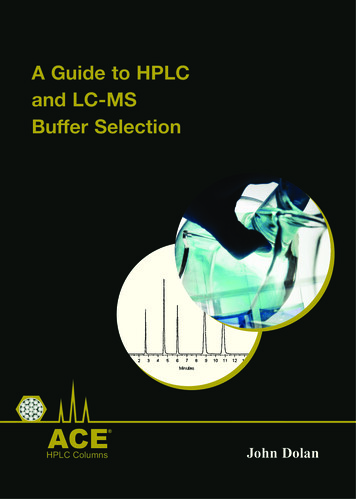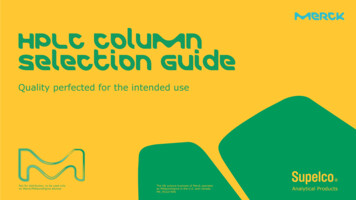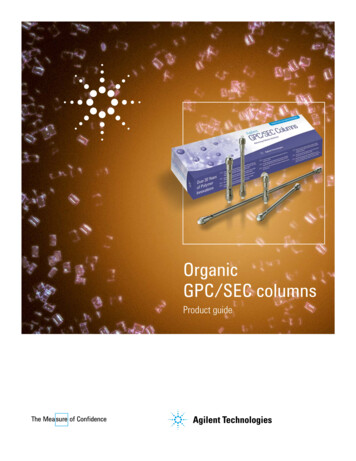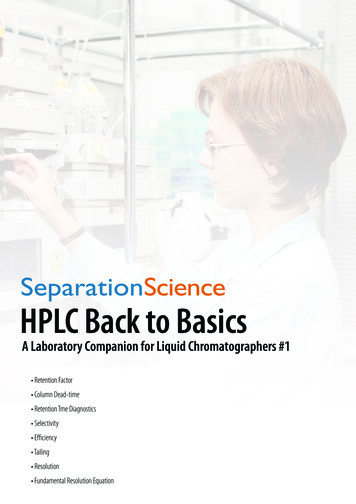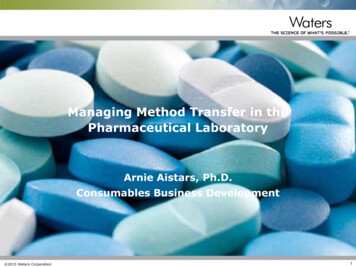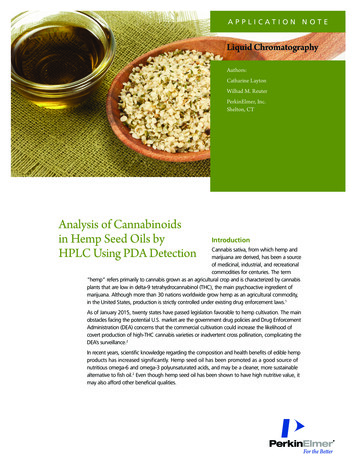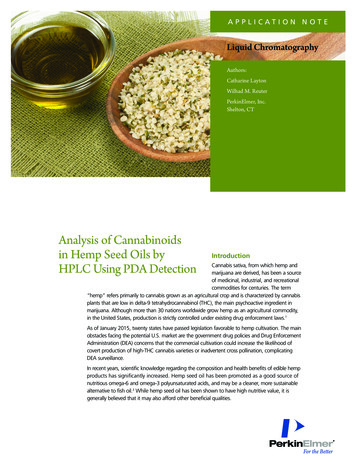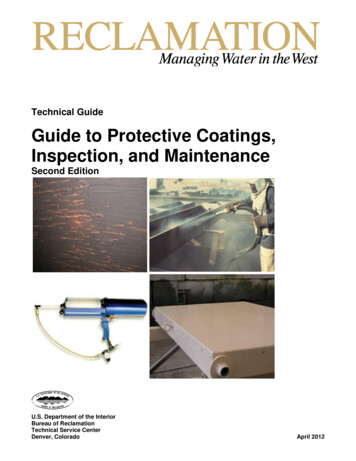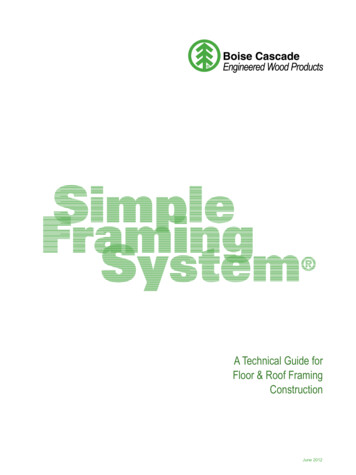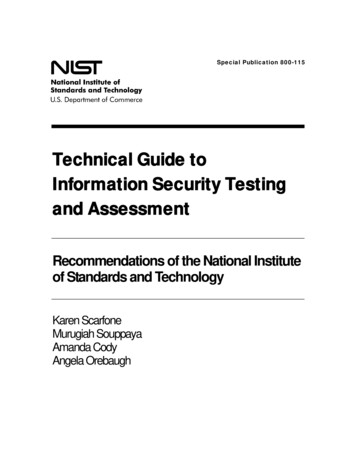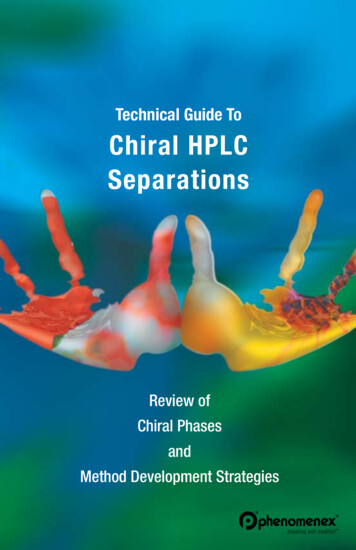
Transcription
Technical Guide ToChiral HPLCSeparationsReview ofChiral PhasesandMethod Development Strategies SM
ArgentinaCzech ranceLuxembourgPuerto ChileGreeceMexicoSaudi ArabiaUnited mbiaIcelandNew ZealandSlovakiaUSACosta RicaIndiaNigeriaIndonesiaNorwaySloveniaSouth AfricaVenezuelaCyprusVietnamPhenomenex products are available worldwide.For the distributor in your country, contactPhenomenex USA, International Department.(310) 212-0555(310) 328-7768international@phenomenex.comUSA411 MadridAve.Torrance,CA90501-1430USAPuerto Rico273 SierraM orenaSuite #104SanJuan,Puerto Rico, 00926Canada411 MadridAve.Torrance,CA90501-1430USAUnited KingdomQueens AvenueHurdsÞeldInd.Est.,MacclesÞeld,Cheshire SK10 2BN,EnglandGerm anyZeppelinstr.5D-63741AschaffenburgDeutschlandNew ZealandP.O. Box 31-601Milford,AucklandNew ZealandAustraliaP.O. Box4084Lane CoveNSW 1595Australia(310)212-0555(310) 328-7768(800)541-HPLC(310) 328-7768(800)543-3681(310) 445E-mailinfo@phenom enex.cominfo@phenom enex.cominfo@phenom enex.comukinfo@phenom enex.comanfrage@phenom enex.cominfo@phenom enex.co.nzinfo@phenom enex.com .auHours6:00AM -5:00PM [PST]10:00AM -7:00PM6:00AM -5:00PM [PST]8:30AM -5:30PM8:30AM -5:30PM8:00AM -5:00PM8:00AM -5:00PMAddressTelephoneFaxCredit ardscWhile every attempt has been made to ensure the accuracy of the informationcontained in this guide, Phenomenex assumes no responsi bility for its use.We welcome any additions or corrections for incor poration into future editions. 2004 Phenomenex, Inc. All rights reserved. No part of this booklet may be copied without priorwritten permission from Phenomenex, Inc. USA.This publication is distributed free of charge.
Technical Guide To Chiral HPLC SeparationsColumn Selection and Method Development TechniquesIntroduction and ObjectivesEffective separations of enantiomers have become increasingly important to thepharmaceutical and agrochemical industry, as well as to biotechnology and mostother areas of natural products chemistry. The rapid introduction of optically active medicinal drugs and pesticides, along with increasing government regulation,necessitates that rapid, sensitive and reliable stereochemical methods be devisedfor their analysis. Chromatography is by far the most powerful and sensitive analytical technique for resolving enantiomers, and chiral HPLC is probably the mostversatile and important tool employed today.This guidebook introduces the concepts of chirality and chiral separations by HPLC,and explores in detail the approach to column selection and method development.It summarizes the techniques used to develop and optimize chiral separations, andteaches by example and illustration. Data have been extracted from a large numberof applications developed by both Phenomenex and our customers.A systematized approach to column selection is presented, and is highly dependent on the structure of your compound. Ultimately, however, column selectionbecomes an empirical process, based on what has already been shown to work,or by exploring column utility for related compounds, or more simply, by trial anderror. Once one or more columns are screened for their utility, optimization of theseparation on a given column is a more methodical and straightforward process.In this guidebook our intention is to suggest by illustration general separationstrategies you can use to successfully resolve and purify enantiomers directlyand without difficulty. There are few hard and fast rules to follow. But in view ofthe applicability and versatility of the chiral stationary phases described here, youshould have confidence that you are working with the most sophisticated toolsavailable today for chiral HPLC.Phenomenex maintains a dedicated chiral separation services laboratory whichcan assist you in developing or improving your chiral separation. Please call on usfor help. We can assist you in column selection, method development, scale up orany other aspect of chiral chromatography. Phenomenex is the leader in advancedchiral separations.
Guidebook OutlineChiral HPLC Separations of Racemic Compounds &Chirality&The Chirotechnology Revolution&HPLC Separation Techniques&Pirkle-Concept Separations&Method Development Techniques&Pharmaceutical Applications
Chirality and Molecular StructureCauses of Molecular Asymmetry due to the arrangement of atoms in spaceChiral CenterC, N, P, S or BChiral AxisAllene substitutionChiral PlaneAtropisomerismMolecular StrainHelicenes,Natural polymersSubstituted BiarylsOrtho-bridging ofBiaryls
Chiral Drugs and their Applicationsas Single Isomers or Racemic Mixturesnaturalsemisynthetic475non-chiral6sold as single isomer461chiral469sold as racemate8Drugs1675non-chiral720sold as single isomer58synthetic1200chiral480sold as racemate422 40% of all man-made synthetic drugs are chiral 60% of all pharmaceuticals are chiral 45% of all chiral drugs are sold as racemates
Stereospecific ActivityS - ( ) - KETOPROFEN( a n a l g e s i c , a n t i i n fl a m m a t o r y )R - (-) - KETOPROFEN(slows periodontalbone loss)2S.3R ( - )levopropoxypheneantitussive2R.3S ( )dextropropoxypheneanalgesicDARVON NOVRADEnantiomers with different types of action. The analgesic action is incompatible with theantitussive, respiration depressant action. Both enantiomers are marketed, one as an analgesic, the other as an antitussive (anti-cough) drug. Their chemical mirror-type relationshipis reflected in the names Darvon and Novrad [9].
Enantiomers May Confer Benefits OverRacemates for Therapeutic UsesProperties of racematePotential benefits of enantiomerOne enantiomer is exclusively activeReduced dose and load on metabolismThe other enantiomer is toxicIncreased latitude in dose and broaderuse of the drugEnantiomers have different pharmacokineticsBetter control of kinetics and doseEnantiomers metabolized at differentrates in the same personWider latitude in setting the dose;reduction in variability of patients’responsesEnantiomers metabolized at differentrates in the populationReduction in variability of patients’responses; greater confidence in settinga single doseOne enantiomer prone to interactionwith key detoxification pathwaysReduced interactions with other common drugsOne enantiomer is agonist, the otherantagonistEnhanced activity and reduction of doseEnantiomers vary in spectra of pharmacological action and tissue specificitySource: Chiros Increased specificity and reduced sideeffects for one enantiomer; use of otherenantiomer for different indication
These drugs are Best Candidatesfor Racemic SwitchesCardiovascularAnti-inflammatory and analgesicsAcebutolol AlprenololCicloprofen CorticosteroidsAtenolol BetaxololDihydroxythebaine FenbuphenBisprolol BopindololFenoprofen FlurbiprofenBucumolol BufetololIbuprofen IndoprofenBufuralol BunitrololKetoprofen MinoxiprofenBupranolol ButofilololPirprofen SteroidsCarazolol CarvedilolSuprofen TriamcinoloneCurteolol DisopyramideDobutamine IndenololMepindolol MetipranololAnticancerCytarabineMetoprolol NadololNicardipine OxpranololPindolol PropanololAntibiotics, antiinfectives,antiviralsSotalol ToliprololCiprofloxacinVerapamil XibenololOfloxacinCentral nervous systemNorfloxacinHormones, genitourinaryDobutamine FluoxetineBenzyl glutamateButoconazoleKetamine LorazepamCalcitoninEstradiolMeclizine olamine estin nitanolTestosteronePolycloramphetamine TomoxetineToloxaton ViloxazinAntihistamine and l/salbutamol MetaproteranolTerbutalineSource: Technology Catalysts InterationalA Racemic Switch is the redevelopment of a drug now marketed as a racemate to the pure enantiomer.
Isomer Separation Flow ChartISOMERSCONSTITUTIONALSTEREOISOMERS ALLY ACTIVESEPARATION OFDIASTEREOMERSBY HPLCNON-TRANSIENTCOMPLEX USINGCHIRAL DERIV.AGENTS (CDA)ACHIRALCHROMATOGRAPHYSILICA, ALUMINA, ETC.TRANSIENT COMPLEX(WEAKLY ASSOCIATED)CHIRAL MOBILEPHASE ADDITIVE(CMPA)CHIRAL STATIONARYPHASE (CSP)CLASSIFICATIONTYPES I - V
Classification ofChiral Stationary Phases us chiral selectorsAttractive interactions(Pirkle)Ionic or covalent bonding Hydrogen BondingCharge transfer (π-π interaction)Dipole stackingIIHELICAL POLYMERSCellulose derivativesPoly methacrylatesInsertion complexesAttractive interactivesPoly acrylamidesIIICAVITYCyclodextrinsInclusion complexesCrown ethersIVLIGAND EXCHANGEAmino acid-metal complexDiastereomeric metal complexVPROTEINa-acid glycoproteinHydrophobic interactionsBovine Serum AlbuminPolar interactionsMACROCYCLICAntibioticVIAttractive interactionsGLYCOPEPTIDEHydrogen BondingInclusion complexesPolar interactionsCharge transfer (π-π interaction)
Pirkle-Concept CSPsMechanism of InteractionEnantiorecognition involves hydrogen bonding, dipolar and charge transfer interactions and steric hindranceachiralspacerchiralmoietytype of interactions:dipole / dipolep/psilicahydrogen bondingsteric hindranceClass-I CSPs and types of interactions that can be involved during the chiral recognition process.soluteenantiomerschiralselectorThe three-point interaction model advanced by Dalgliesh10
Chiral Stationary Phases (CSPs)CSP TYPE II. INSERTION COMPLEXHELICAL POLYMERS (Natural CELLULOSES andDERIVATIVES and VARIOUS SYNTHETIC sanAcetatesDextranEsterslinear poly[1 - 4 - b - D -glucose]CarbamatesSynthetic:(a) Use of chiral substituent:polymerizationcrosslinkingchiral monomerchiralpolymer network(b) Use of chiral catalyst:PolymethacrylatesPolyacrylamidesisotactic (stereoregular)polymerAdopts a single helicalconformation11
Chiral Stationary Phases (CSPs)CSP TYPE III. INCLUSION (CAVITY) COMPLEXCYCLODEXTRINS and yclodextrinb-Cyclodextring-CyclodextrinThe structure of a, b and g cyclodextrin.Schematic showing the reversible inclusion complex formation typical of cyclodextrin bonded stationary phase.CSP Type IV. Ligand ExchangeDiastereomeric Metal ComplexIllustration of the principle of chiral ligand exchange used for chromatographic optical resolution.Reversible formation of diastereomeric metal complexes is obtained in a reaction between achiral selector (left-hand side) and the respective enantiomers (right-hand side).12
Chiral Stationary Phases (CSPs)CSP Type V. ProteinAGP, BSA, HSA, OVOMUCOIDCSP Type VIMacrocyclic/antibioticvancomycin, teicoplanin, ristocetin13
The Chirex Advantage14FWide variety of supportsFHigh enantioselectivityFHigh efficiency, covalently bound columnsFChemically stable and rigid supportsFChoice of elution order (opposite CSPs available)FPacked columns from minibore to preparative
Chiral Stationary PhasesStationary phases in Chirex columns contain various chiral components. They are classified intothree types: amide, urea and ligand exchange types. In the amide type, asymmetric carbon atomsare bonded directly with the CONH group, and in the urea type, asymmetric carbon atoms with theNHCONH group, and they are chemically (covalently or ionically) bonded to silica gel. In the ligandexchange type, the chiral components are coated hydrophobically on ODS.CHIREXChiral ters, amides, carboxylic3005(R)-I-naphthylglycineRPacids, alcohols, ketones3010(S)-valineRPcarboxylic acids (including3011(S)-tert-leucineRPZ-amino acids, BOC-aminoRPacids, benzoylamino acids)Amide typeUrea phthyl)ethylamineNP(S)-proline,amines, amides, aminoNP3017(S)-I-(a-naphthyl)ethylaminealcohols, alcohols, esters,(S)-prolinephosphoric ne-2-carboxylic nge type3126(D)-penicillamineRPa-amino acids, a-hydroxy acids*NP : Normal phase modeRP : Reverse phase mode, typically consisting of ammonium acetate in methanolEnantiomeric stationary phases are available except for 3022, and on this phase the elution order of enantioners areinverted.15
Chirex Chiral Stationary Phases (CSPs)PhaseDescriptionStructureAMIDE TYPE3001(R)-phenylglycine and 3,5-dinitrobenzoic acidamide linkage, electron acceptordesigned for the separation ofcarboxylic acids, alcohols, esterssulphoxides3005(R)-1-naphthylglycine and 3,5-dinitrobenzoic acidamide linkage, electron acceptordesigned for the separation of:carboxylic acids, alcohols, estersnon-steroidal anti-inflammatory agentsUREA TYPE3010(S)-valine and 3,5-dinitroanilineurea linkage, electron acceptordesigned for the separation of:carboxylic acids, amino acid derivativeshydroxy acidsDabsyl and Dansyl derivatives of amino acids3011(S)-tert-leucine and 3,5-dinitroanilineurea linkage, electron acceptordesigned for the separation of:carboxylic acids, amino acid derivatives3012(R)-phenylglycine and 3,5-dinitroanilineurea linkage, electron acceptordesigned for the separation of:carboxylic acids, amino acid derivatives3014(S)-valine and (R)-1-(α-naphthyl)ethylamineurea linkage, electron donordesigned for the separation of:π-acceptor derivatives of amines,carboxylic acids and amino acidsthe esters and amides of these acidsunderivatized alcohols3017(S)-proline and (S)-1-(α-naphthyl)ethylamineurea linkage, electron donordesigned for the separation of:amines, alcohols and amino acidsun
Technical Guide To Chiral HPLC Separations Column Selection and Method Development Techniques InTroduCTIon and objeCTIveS Effective separations of enantiomers have become increasingly important to the pharmaceutical and agrochemical industry, as well as to biotechnology and most other areas of natural products chemistry. The rapid introduction of optically ac-tive medicinal
